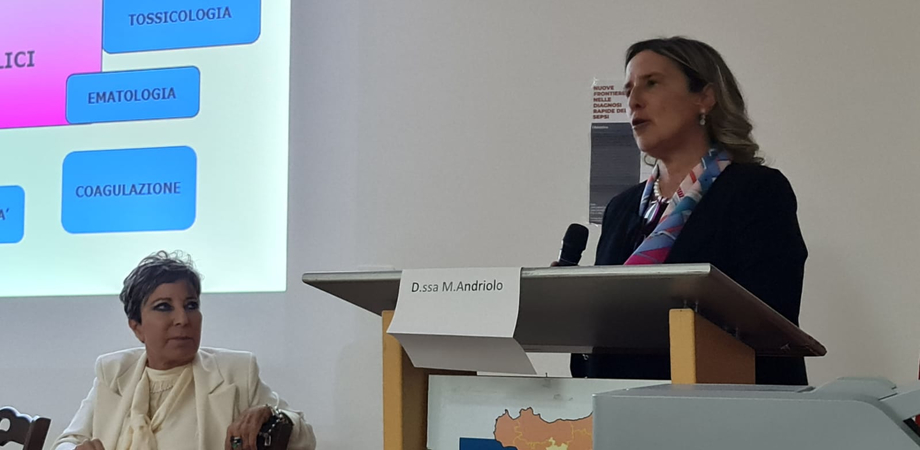Rita Cinardi
28 October 2022 10:48
The conference entitled “New frontiers in the rapid diagnosis of sepsis”, organized by the director of the Sant’Elia Clinical Pathology Unit, Maria Andriolo, was held in the congress hall of the Sant’Elia hospital. At the congress, which was moderated by the sanitary director of the Asp of Caltanissetta Marcella Santino, the professor Celestino Bonura, director of the Complex Operating Unit of Microbiology and Virology of the Palermo polyclinic, the professor Guzman of the University intervened as speakers of Boston, professor Antonio Federico, medical director of the Intensive Care Unit Complex of the Palermo Polyclinic, the director of the Complex Operational Unit of the Infectious Diseases Department of the Gela hospital Fabrizio Pulvirenti, and the Italy manager of Did Milano Ada Esposito
“The clinical pathology laboratory of the Sant’Elia hospital – explains Dr. Andriolo – is equipped with a new tool for the search for pathogens in the event of sepsis. It is an innovative system, in Sicily there are only four, which uses molecular biology methods that allow the determination of pathogens, bacterial or fungal, in patients diagnosed with sepsis in just three hours from receiving the blood count tube. This tool is certainly very useful for intensive care, first aid and infectious disease departments, oncohematology and for internal medicine departments. Sepsis – she explains – is a rare complication of an infection whose consequences can be very serious and partially fatal. It consists of an excessive inflammatory response of the body to a generalized infection that damages tissues and organs, compromising their functioning. Without immediate treatment it can result in death. Every year 700 thousand heads of sepsis are recorded in Europe, of which at least 1 in 5 with a fatal outcome. Sepsis can affect anyone who has contracted an infection, however it is more common in infants, children, the elderly, and people with persistent, chronic, or other medical conditions that weaken the immune system. People admitted to hospital are more at risk of sepsis if they have just undergone surgery or have been implanted with a medical device, such as a urinary catheter or venous catheter. The longer the hospital stay, the greater the risk of developing it. Laboratory medicine – concludes Dr. Andriolo – is the crossroads of all the disciplines and operational units of a hospital. Making early and molecular diagnosis is a sign of efficiency and economy “.
The conference entitled “New frontiers in the rapid diagnosis of sepsis”, organized by the director of the Sant’Elia Clinical Pathology Complex Operative Unit, Maria Andriolo, was held in the congress hall of the Sant’Elia hospital. At the congress, which was moderated by the medical director of the ASP of Caltanissetta Marcella Santino, Professor Celestino Bonura, director of the Complex Operating Unit of Microbiology and Virology of the Palermo Polyclinic, took part as speakers. , Professor Antonio Federico, medical director of the Intensive Care Complex Operating Unit of the Palermo Polyclinic, the director of the Complex Operating Unit of the Infectious Diseases Department of the Gela hospital Fabrizio Pulvirenti, and the Italy manager of Did Milano Ada Esposito
“The clinical pathology laboratory of the Sant’Elia hospital – explains Dr. Andriolo – is equipped with a new tool for the search for pathogens in case of sepsis. It is an innovative system, in Sicily there are only four, which uses molecular biology methods that allow the determination of pathogens, bacterial or fungal, in patients diagnosed with sepsis in just three hours from receipt of the blood count tube. This tool is certainly very useful for intensive care, emergency room and wards of Infectious Diseases, Oncohematology and for the departments of Internal Medicine. Sepsis – he explains – a rare complication of an infection whose consequences can be very serious and partially fatal. It consists of an excessive inflammatory response of the organism to an infection which damages tissues and organs compromising their functioning. Without immediate treatment it can cause death. Every year 700m are recorded in Europe ila head of sepsis, of which at least 1 in 5 with fatal outcome. Sepsis can affect anyone who has contracted an infection, but it is more common in infants, children, the elderly, and people with persistent, chronic, or other medical conditions that weaken the immune system. People admitted to hospital are more at risk of sepsis if they have just undergone surgery or have been implanted with a medical device, such as a urinary catheter or venous catheter. The longer the hospital stay, the greater the risk of developing it. Laboratory medicine – concludes Dr. Andriolo – is the crossroads of all the disciplines and operational units of a hospital. Early and molecular diagnosis is a sign of efficiency and economy “.
